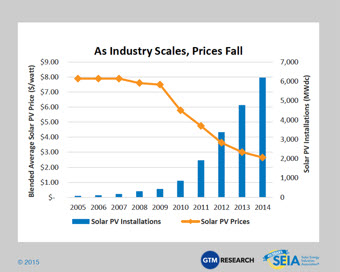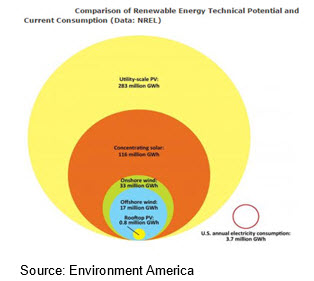WASHINGTON, April 7, 2016 - America can address its largest environmental challenges by shifting to 100 percent renewable energy, says a panel of academic experts and clean energy advocates.
David Freeman, utility CEO and author of “All-Electric America,” and other experts joined Environment America and Frontier Group recently for an online presentation and discussion of their new white paper, “We Have the Power: 100 Percent Renewable Energy for a Clean, Thriving America,” which lays out “whys, wherefores, and how-to’s for transforming the nation’s energy supply entirely to wind, solar, and other non-polluting sources.”
“My colleagues have exhaustively proven, in infinite detail, that we can put together an electric power supply that’s all renewable,” says Freeman.
The report asserts that there are “no insurmountable technological or economic barriers to 100 percent renewable energy.” Some seven detailed studies of clean energy systems, conducted by academics, government agencies and nonprofit organizations, suggest that the U.S. has the tools needed to make the transition, the panel says.
 “There’s very little downside to the transition,” says Mark Jacobson of
Stanford University, author of several studies showing the feasibility of 100
percent clean energy. “We think this is a winning situation for everyone in the
long term.”
“There’s very little downside to the transition,” says Mark Jacobson of
Stanford University, author of several studies showing the feasibility of 100
percent clean energy. “We think this is a winning situation for everyone in the
long term.”Among the paper’s conclusions:
- A shift to 100 percent renewable energy can limit the impacts of global warming. The 2015 Paris Agreement pledges the U.S. to pursue efforts to limit global temperature increase to 1.5 degrees Centigrade above pre-industrial levels. America must transition to 100 percent clean energy before mid-century and leave most U.S. remaining coal, oil and gas reserves in the ground to achieve that goal.
- Renewable energy improves the public health, increases safety and puts the country’s economy on a sound foundation. The expansion of renewable energy creates local jobs that cannot be outsourced, reduces the impact of fossil fuel-induced harm to the environment and health and safeguards the economy from the volatility of fossil fuel prices. America has vast renewable energy resources. According to the National Renewable Energy Laboratory, the U.S. has the technical potential to meet its current electricity needs more than 100 times over with solar energy and more than 10 times over with wind energy. The American Council for an Energy-Efficient Economy estimates that we can reduce overall energy use by 40 to 60 percent below current levels by mid-century, even as the U.S. economy continues to grow.
- Affordable 100 percent renewable energy is within reach. Economists predict that the U.S. can build a 100 percent renewable energy system at costs comparable to or less than what it would have to spend to continue its reliance on existing energy sources. The International Energy Agency estimates that limiting warming to 2 degrees C would require an additional investment of about 1 percent of global GDP per year. That investment would yield savings of more than $115 trillion on fuel by 2050 – a net savings of more than $70 trillion.
- Emerging technologies and new trends are opening the door for an unprecedented transformation of the U.S. energy system to 100 percent clean, renewable power. Renewable energy and energy efficiency technologies are rapidly falling in price, improving in performance and providing new tools.
The report suggests that leaders at all levels of government
should act to accelerate the transition to 100 percent renewable energy and
recommends five key principles to guide America’s energy policy -- many of
which will be controversial with traditional energy providers:
policy -- many of
which will be controversial with traditional energy providers:
- Prioritize energy savings;
- Conserve energy and use it more efficiently to ease the transition from “dirty” fuels to clean, renewable energy;
- Promote steady and swift deployment of clean renewable energy sources transition those portions of the economy that rely on direct combustion of fossil fuels to electricity and other zero-carbon energy carriers;
- Provide reliable access to renewable energy by modernizing the electricity grid and enabling community microgrids and grid-connected energy storage; and
- Keep much of U.S. coal, oil and gas reserves in the ground and cease construction of new fossil fuel infrastructure for health reasons and to protect the global climate.
#30
For more news, go to: www.agri-pulse.com

